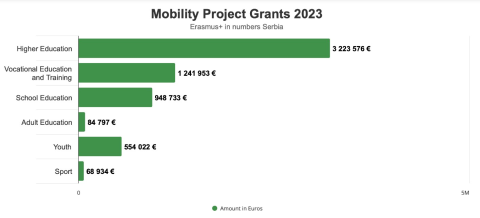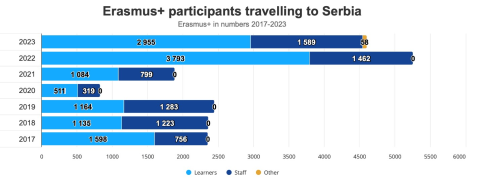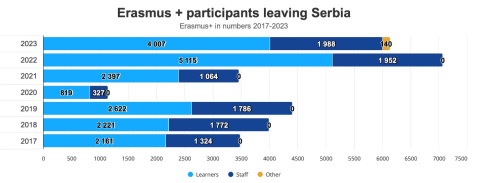Address
Eurydice Unit Serbia
Foundation Tempus
Ruze Jovanovic 27a
RS-11000 Belgrade
Tel: +381 11 33 42 430
E-Mail: eurydice@tempus.ac.rs
Website
The mobility opportunities for schools and preschool education institutions are primarily linked to participation in international cooperation projects.
Serbia became an Erasmus+ Programme Country in 2019, which allowed it to participate in more actions in higher education and youth, as well as in those in the fields of sport, vocational education and training, school education and adult education. As a result, all students, teachers and other school staff can fully participate in mobility projects, as well as in bilateral or multilateral cooperation projects.
Pupils and Student Mobility
According to the Erasmus+ in Serbia 2023 report, as part of Key Action 1 – Learning Mobility of Individuals, the largest number of mobility projects in 2023 were in the field of school education (59 mobility projects), followed closely by higher education (44 projects) and VET (37 projects).
In 2023, a total of EUR 948,733 in grants was approved for mobility projects in school education and EUR 1,241,953 was allocated for mobility projects in the field of VET. Figure 1 illustrates a comparison of grants awarded across different fields.
Figure 1: Mobility Project Grants in Serbia in 2023

Source: Erasmus+ in Serbia 2023. Statistics on mobility, cooperation and other data
When it comes to participants in 2023, around 64% of incoming mobility participants and 65% of outgoing mobility participants were learners.
Compared to 2022, there was a noticeable decrease in the total number of mobility participants, both incoming and outgoing, as shown in Figures 2 and 3.
Figure 2: Incoming Mobility Participants

Source: Erasmus+ in Serbia 2023. Statistics on mobility, cooperation and other data
Figure 3: Outgoing Mobility Participants

Source: Erasmus+ in Serbia 2023. Statistics on mobility, cooperation and other data
In addition to the Erasmus+ programme, there are other mobility options for learners.
One of them is the Future Leaders Exchange (FLEX) Programme, (formerly A-SMYLE), which has been active in Serbia since 2005. This is a programme sponsored by the United States Department of State for final-grade students of lower secondary and first- or second-grade students of upper secondary education from Eurasian countries.
The programme provides merit-based scholarships for students to travel to the United States, live with a host family and attend a U.S. high school for a full academic year. The programme is free of charge as it is funded by the Government of the United States.
Teacher Mobility
Teacher mobility has been steadily increasing through participation in Erasmus+ projects. By participating in these projects, teachers improve their professional competences, enhance foreign language skills and develop awareness and understanding of other cultures. At the same time, the projects are perceived as potentially beneficial for increasing the capacity of educational institutions for international cooperation.
For example, the number of staff (of which teachers make up a significant portion) who had participated in outgoing mobilities increased in 2023. As Figure 3 shows, 27.6% of outgoing mobility participants in 2022 were educational staff, while this number was 32.4% in 2023.
Additionally, as of 2015, Serbia has been a member of the eTwinning network. This network enables schools from Serbia to participate in virtual projects with schools from other countries – members of the network. This way, teachers and students can engage in learning through virtual mobility. Moreover, one of the key features of this digital communication platform is the possibility of learning languages and ICT skills.
In 2018, the eTwinning School label was introduced, recognising institutions that embrace eTwinning values, such as European collaboration, inclusion and innovation, shared leadership and active student participation.
In 2022, eTwinning was integrated into a unified platform – the European Platform for School Education.
As of 2025, nearly 5,300 educators, teachers, and professionals from more than 1,130 institutions in Serbia are registered on the eTwinning portal. In the past ten years, teachers from Serbia have initiated 5,668 projects.
